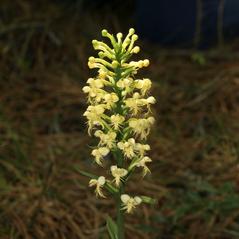Platanthera pallida P. M. Brown
Pale Fringed Orchid
Facts About
Accepted Synonyms: Blephariglottis pallida
Platanthera pallida, the Pale Fringed Orchid, is endemic to Long Island, New York, restricted to dry, dune slopes. This orchid grows among pitch pine scrub and has 2-3 large lower leaves and upper leaves that are reduced to 3-5 linear bracts. The cream colored flower with a recurved, fringed lip and short nectar spur may distinguish this orchid from Platanthera cristata, a similar species that prefers a wetter habitat.
Although Platanthera pallida is presented here as a unique species, discussions continue among botanists about whether this distinction is warranted. The New York Natural Heritage Program, among others, identifies these orchids as Platanthera cristata- exhibiting characteristics found within the normal range for this species. Further research into the biology of Platanthera pallida, including its pollination mechanism and mycorrhizal fungi, and the application of molecular tools, may shed light on these discussions.
Pollination
Pollinator information for this orchid has not been reported.
Ecosystem Type
Dunes, shrublands or thickets, woodlands
Characteristics
- Habitat:
- terrestrial
- Leaf arrangement:
-
- alternate
- stem
- Number of leaves on stem:
-
- two
- three
- Form of the labellum:
- the labellum is not pouch-like
- Main color of labellum:
-
- white
- yellow
- Nectar spur:
- present
- Inflorescence type:
- the inflorescence is a raceme
- Labellum characteristics:
-
- the labellum has a spur
- the labellum is fringed
- Labellum length:
- Up to 3 mm
- Sepal length:
- Up to 3 mm
- Plant height:
- 29–65 cm
-
Flowers
- Floral bract length:
- Up to 22 mm
- Flower petal color:
-
- white
- yellow
- Flower symmetry:
- the flower is zygomorphic
- Flowering date:
-
- July
- August
- September
- Flowers per inflorescence:
- 24–80
- Form of the labellum:
- the labellum is not pouch-like
- Inflorescence length:
- 100–200 mm
- Inflorescence type:
- the inflorescence is a raceme
- Inflorescence width:
- 25–40 mm
- Labellum characteristics:
-
- the labellum has a spur
- the labellum is fringed
- Labellum length:
- Up to 3 mm
- Labellum position:
- the flowers are resupinate
- Lower petal strongly red-veined:
- no
- Main color of labellum:
-
- white
- yellow
- Nectar spur:
- present
- Nectar spur length:
- 5–6 mm
- Number of stamens:
- 1
- Pollen sacs:
- the pollinia remain intact and do not fragment into smaller parts
- Self-pollinating flowers:
- there are no cleistogamous flowers
- Sepal length:
- Up to 3 mm
- Spots on labellum:
- no
- Spur opening membrane:
- there is no membrane over the spur opening
- Spur opening shape:
- roughly shaped like a keyhole
-
Fruits or seeds
- Fruit length:
- 10–16 mm
- Seed capsule orientation:
- the capsule points upwards or outwards
-
Growth form
- Plant height:
- 29–65 cm
- Roots:
- the rhizomes are non-coralloid
- Underground organs:
- slender roots
- myco-heterotrophic or not:
- the plant is chlorophyllous
-
Leaves
- Leaf arrangement:
-
- alternate
- stem
- Leaf blade edges:
- the leaf edges are entire
- Leaf blade length:
- Up to 250 mm
- Leaf blade shape:
-
- lanceolate
- linear
- Leaf blade tip:
-
- the tip of the leaf blade is acuminate
- the tip of the leaf blade is acute
- Leaf blade width:
- 30–50 mm
- Leaves during flowering:
- leaves are present during flowering
- Number of bracts on stem:
- 3–5
- Number of leaves on stem:
-
- two
- three
-
Place
- Ecosystem type:
-
- dunes
- shrublands or thickets
- woodlands
- Habitat:
- terrestrial
- Location:
- New York
-
Facts and Uses
- Mycorrhiza
- Monitoring
- Propagation
- Restoration
Native to North America
Yes
North American Conservation Status & Distribution
Conservation Status
| Conservation and Wetland Status | |
|---|---|
| Global Rank | N/A |
| US Status | N/A |
| Canadian Status | N/A |
| Conservation status for: New York | |
|---|---|
| Global Rank | N/A |
| US Status | N/A |
| New York Rank | N/A |
| New York Status | N/A |
| Canadian Status | N/A |
| Wetland Status | N/A |





